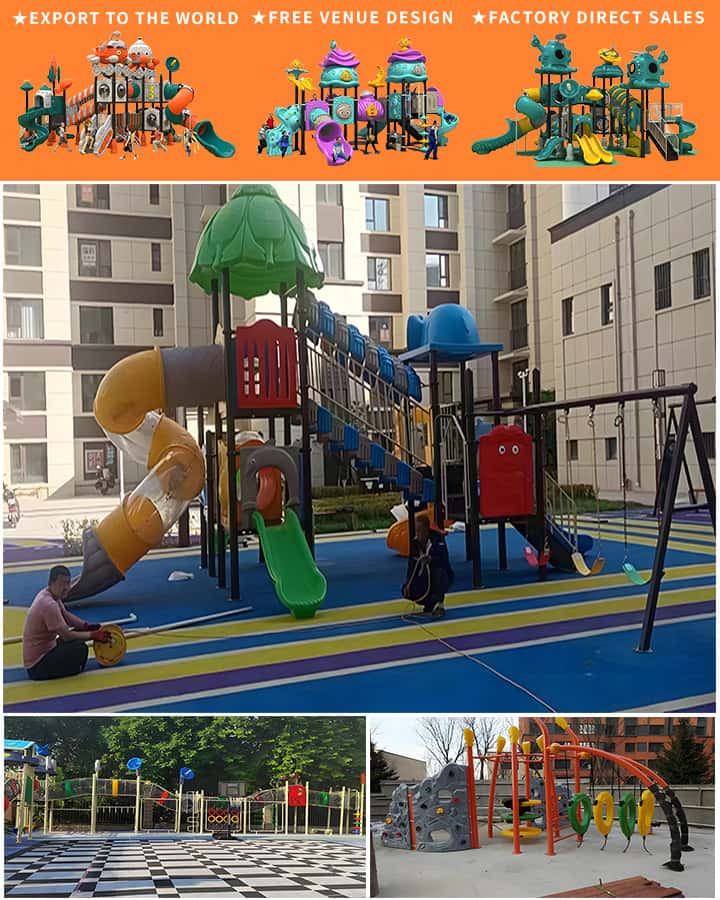Playgrounds are a vital part of any community, offering children a space to play, exercise, and socialize. However, selecting the right playground floor material is crucial not only for the safety of the children but also for the long-term durability and maintenance of the area. In this guide, we dive into various options available for outdoor playground flooring and their benefits, helping you make an informed decision for your community’s outdoor playground needs.
1. Rubber Tiles
Benefits:
- Safety First: Rubber tiles offer excellent shock absorption, reducing the risk of injuries from falls.
- Durability: These tiles are resistant to UV rays, weather elements, and heavy foot traffic.
- Variety: Available in multiple colors and thicknesses, allowing for custom designs and layouts.
- Easy Installation: They can be easily installed over existing surfaces without much hassle.
Considerations:
- Cost: Can be more expensive compared to other materials.
- Maintenance: Periodic cleaning is required to maintain optimal performance and appearance.
2. Poured-in-Place Rubber
Benefits:
- Customizable: Can be poured directly onto the ground, allowing for seamless surfaces with no seams or gaps.
- Safety: Offers superior fall protection by providing consistent cushioning across the entire surface.
- Color Options: Can be colored to match playground designs or educational themes.
- Longevity: With proper installation, it can last many years.
Considerations:
- Installation Time: Takes longer to install compared to other materials.
- Cost: Generally more expensive due to the extensive labor and materials involved.

3. Artificial Turf
Benefits:
- Aesthetic Appeal: Mimics the look and feel of natural grass while offering a low-maintenance solution.
- Durability: Resistant to wear and tear from heavy use.
- Safety: Often combined with a rubber base layer to enhance fall protection.
- All-Weather: Performs well in various weather conditions, staying green year-round.
Considerations:
- Initial Install Cost: Can be high depending on the quality of turf used.
- Infill: Some artificial turfs require infill materials which may need periodic replenishment.
4. Wood Chips
Benefits:
- Natural Look: Provides an organic aesthetic that blends well with outdoor environments.
- Eco-Friendly: Made from renewable resources and biodegradable.
- Cost-Effective: Generally cheaper than other synthetic materials.
Considerations:
- Maintenance: Requires frequent raking and replenishment to maintain a safe and even surface.
- Safety: Less effective in absorbing falls compared to rubber materials.
- Pests: May attract insects or rodents which could be a concern for some communities.
5. Bonded Mulch
Benefits:
- Shock Absorption: Offers good cushioning properties, making it safer than wood chips alone.
- Longevity: More durable than loose wood chips as it’s applied with a binder.
- Low Maintenance: Doesn’t require as much upkeep as loose wood chips.
Considerations:
- Initial Cost: Higher than traditional wood chips due to the binding process.
- Limited Lifespan: Eventually, it will need to be replaced or reapplied over time.
Making the Right Choice for Your Outdoor Playground
When deciding on the best playground floor material for your outdoor space, consider the following factors:
- Safety: Prioritize materials that provide excellent shock absorption and minimize injury risks.
- Budget: Balance between initial costs and long-term maintenance expenses.
- Aesthetics: Choose a material that complements the overall design and theme of the playground.
- Maintenance: Evaluate how much upkeep each material requires and your ability to manage it.
By carefully considering these aspects, you can select a playground floor material that ensures a safe, engaging, and lasting environment for children to enjoy. Whether you opt for the resilience of rubber, the eco-friendliness of wood chips, or the low-maintenance appeal of bonded mulch, your choice will significantly impact the playground’s functionality and appeal.




